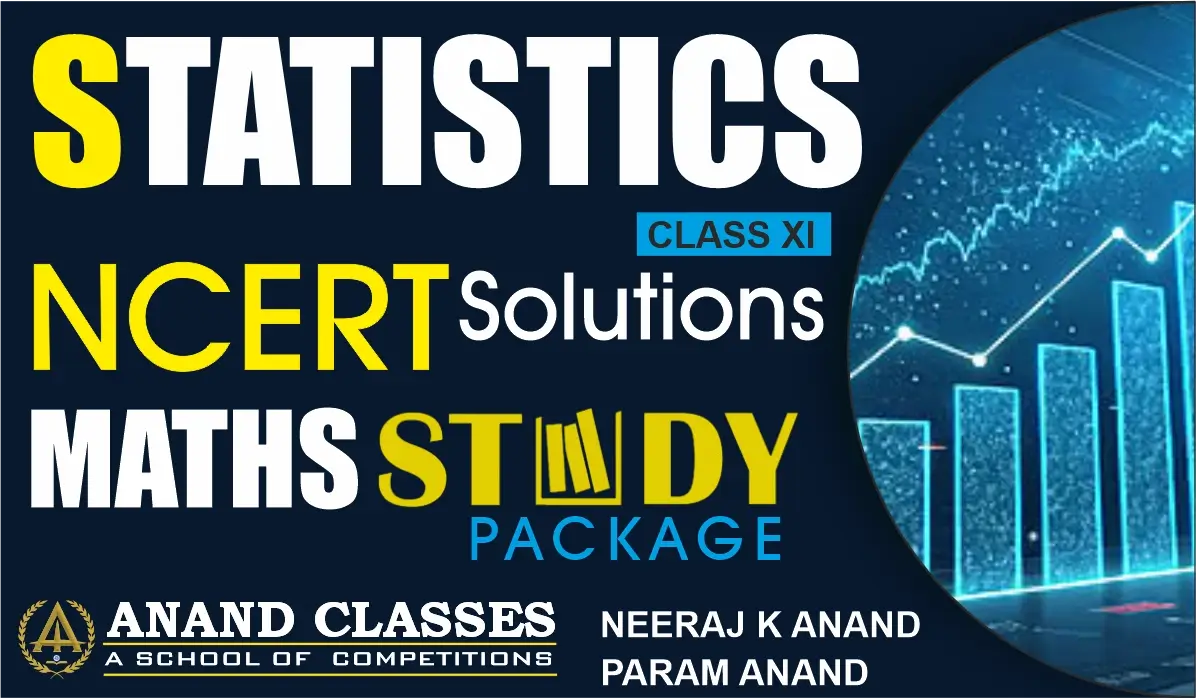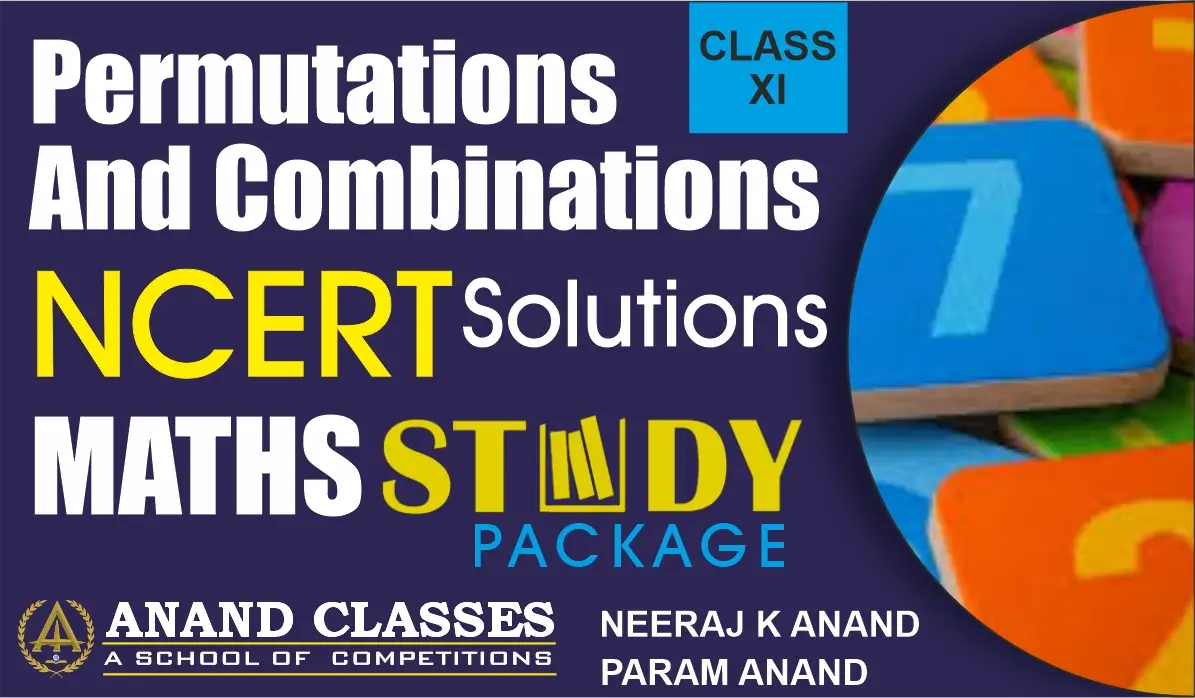Anand Classes offers comprehensive NCERT Solutions for Class 11 Maths Chapter 13 Statistics Miscellaneous Exercise, designed to help students practice mixed problems based on mean deviation, variance, standard deviation, and correlation. These step-by-step solutions are prepared according to the latest CBSE and NCERT syllabus, ensuring clarity and accuracy. Each question is solved with clear explanations, making it easier for students to revise key formulas and improve their statistical problem-solving skills. Click the print button to download study material and notes.
NCERT Question 1 : The mean and variance of eight observations are $9$ and $9.25$ respectively.
If six of the observations are $6, 7, 10, 12, 12$ and $13$, find the remaining two observations.
Solution :
Six of the observations are $\lbrace 6, 7, 10, 12, 12, 13\rbrace$ (given).
Let the remaining two observations (out of $n = 8$) be $a$ and $b$.
We know that mean $\bar{x} = \dfrac{\sum x}{n}$.
But $\bar{x} = 9$ (given).
$$
9 = \frac{6 + 7 + 10 + 12 + 12 + 13 + a + b}{8}
$$
$$
\Rightarrow (9 \times 8) = 72 = 60 + a + b
$$
$$
\therefore a + b = 12 \quad \text{…(i)}
$$
We also know that variance is given by
$$
\sigma^2 = \frac{1}{n} \sum x^2 – (\bar{x})^2
$$
Putting $\sigma^2 = 9.25$, $\bar{x} = 9$, and $n = 8$, we have
$$
9.25 = \frac{6^2 + 7^2 + 10^2 + 12^2 + 12^2 + 13^2 + a^2 + b^2}{8} – 9^2
$$
$$
9.25 + 81 = \frac{36 + 49 + 100 + 144 + 144 + 169 + a^2 + b^2}{8}
$$
$$
90.25 \times 8 = 642 + a^2 + b^2
$$
$$
722 – 642 = a^2 + b^2
$$
$$
\therefore a^2 + b^2 = 80 \quad \text{…(ii)}
$$
From (i), $b = 12 – a$. Substituting in (ii):
$$
a^2 + (12 – a)^2 = 80
$$
$$
a^2 + 144 + a^2 – 24a = 80
$$
$$
2a^2 – 24a + 64 = 0
$$
Dividing by $2$:
$$
a^2 – 12a + 32 = 0
$$
$$
(a – 4)(a – 8) = 0
$$
Hence,
$$
a = 4 \quad \text{or} \quad a = 8
$$
When $a = 4$, $b = 12 – 4 = 8$
When $a = 8$, $b = 12 – 8 = 4$
$$
\boxed{\text{The remaining two observations are } 4 \text{ and } 8.}
$$
Download detailed NCERT solutions by Anand Classes for Class 11 Maths, JEE Main, NDA, and CUET preparation.
NCERT Question 2 : The mean and variance of $7$ observations are $8$ and $16$ respectively.
If five of the observations are $2, 4, 10, 12, 14$, find the remaining two observations.
Solution :
Five of the observations are ${2, 4, 10, 12, 14}$ (given).
Let the remaining two observations (out of $n=7$) be $a$ and $b$.
Mean $\bar{x}=\dfrac{\sum x}{n}$. Given $\bar{x}=8$. Hence
$$
8=\frac{2+4+10+12+14+a+b}{7}
$$
$$
\Rightarrow 8\times7=56=42+a+b
$$
$$
\therefore a+b=14 \qquad\text{…(i)}
$$
Variance $\sigma^{2}=\dfrac{1}{n}\sum x^{2}-(\bar{x})^{2}$. Given $\sigma^{2}=16,;\bar{x}=8,;n=7$.
$$
16=\frac{2^{2}+4^{2}+10^{2}+12^{2}+14^{2}+a^{2}+b^{2}}{7}-8^{2}
$$
Move $8^{2}=64$ to LHS:
$$
16+64=\frac{4+16+100+144+196+a^{2}+b^{2}}{7}
$$
$$
80\times 7 = 4+16+100+144+196 + a^{2}+b^{2}
$$
$$
560 = 460 + a^{2}+b^{2}
$$
$$
\therefore a^{2}+b^{2}=100 \qquad\text{…(ii)}
$$
From (i), $b=14-a$. Substitute in (ii):
$$
a^{2}+(14-a)^{2}=100
$$
$$
a^{2}+196+a^{2}-28a=100
$$
$$
2a^{2}-28a+96=0
$$
Divide by $2$:
$$
a^{2}-14a+48=0
$$
Factor:
$$
(a-6)(a-8)=0
$$
Thus $a=6$ or $a=8$.
If $a=6$, then $b=14-6=8$.
If $a=8$, then $b=14-8=6$.
$$
\boxed{\text{The remaining two observations are }6\text{ and }8.}
$$
Download detailed NCERT solutions by Anand Classes for Class 11 Maths, JEE Main, NDA, and CUET preparation.
NCERT Question 3 : The mean and standard deviation of six observations are $8$ and $4$ respectively.
If each observation is multiplied by $3$, find the new mean and new standard deviation of the resulting observations.
Solution :
Let the six observations be $x_1, x_2, x_3, x_4, x_5, x_6$.
Mean:
$$
\bar{x} = \frac{\sum x_i}{6} = 8 \quad \text{(given)}
$$
Hence,
$$
\sum x_i = 8 \times 6 = 48 \quad \text{…(i)}
$$
Standard deviation:
$$
\sigma_x = \sqrt{\frac{\sum x_i^2}{6} – \bar{x}^2} = 4
$$
Squaring both sides:
$$
\frac{\sum x_i^2}{6} – 8^2 = 16
$$
$$
\frac{\sum x_i^2}{6} = 16 + 64 = 80
$$
$$
\sum x_i^2 = 80 \times 6 = 480 \quad \text{…(ii)}
$$
When each observation is multiplied by 3
The new observations are
$$y_i = 3x_i, \quad i = 1, 2, …, 6.$$
New mean:
$$
\bar{y} = \frac{\sum y_i}{6} = \frac{\sum 3x_i}{6} = 3 \times \frac{\sum x_i}{6} = 3 \times 8 = 24
$$
Thus,
$$
\boxed{\bar{y} = 24 = 3\bar{x}}
$$
New standard deviation:
$$
\sigma_y = \sqrt{\frac{\sum y_i^2}{6} – \bar{y}^2}
$$
Since $y_i = 3x_i$, we have $y_i^2 = 9x_i^2$.
Substitute:
$$
\sigma_y = \sqrt{\frac{9\sum x_i^2}{6} – (3\bar{x})^2}
$$
$$
= \sqrt{9\left(\frac{\sum x_i^2}{6} – \bar{x}^2\right)} = 3\sqrt{\frac{\sum x_i^2}{6} – \bar{x}^2}
$$
$$
\sigma_y = 3\sigma_x = 3 \times 4 = 12
$$
$$
\boxed{\text{New Mean } = 24,\quad \text{New Standard Deviation } = 12.}
$$
For more NCERT Class 11 Maths solutions with detailed explanations and examples, visit Anand Classes — your trusted learning resource for JEE, NDA, and CUET preparation.
NCERT Question 4 : Given that $\bar{x}$ is the mean and $\sigma^{2}$ is the variance of $n$ observations $x_{1},x_{2},\dots,x_{n}$. Prove that the mean and variance of the observations $ax_{1},ax_{2},\dots,ax_{n}$ are $a\bar{x}$ and $a^{2}\sigma^{2}$ respectively, $(a\neq 0)$.
Solution :
By definition,
$$
\bar{x}=\frac{1}{n}\sum_{i=1}^{n}x_i,
\qquad
\sigma^{2}=\frac{1}{n}\sum_{i=1}^{n}(x_i-\bar{x})^{2}
=\frac{1}{n}\sum_{i=1}^{n}x_i^{2}-\bar{x}^{2}.
\qquad\text{(1)}
$$
Let the new observations be $y_i=ax_i;(i=1,2,\dots,n)$.
Mean of the new observations.
$$\bar{y}=\frac{1}{n}\sum_{i=1}^{n}y_i$$
$$\bar{y} =\frac{1}{n}\sum_{i=1}^{n}a x_i$$
$$\bar{y} =a\left(\frac{1}{n}\sum_{i=1}^{n}x_i\right)$$
$$\bar{y} =a\bar{x}.$$
Variance of the new observations. Using the definition,
$$\sigma_{y}^{2}=\frac{1}{n}\sum_{i=1}^{n}(y_i-\bar{y})^{2}$$
$$\sigma_{y}^{2}=\frac{1}{n}\sum_{i=1}^{n}\big(ax_i-a\bar{x}\big)^{2}$$
$$\sigma_{y}^{2} =\frac{1}{n}\sum_{i=1}^{n}a^{2}(x_i-\bar{x})^{2}$$
$$\sigma_{y}^{2}=a^{2}\left(\frac{1}{n}\sum_{i=1}^{n}(x_i-\bar{x})^{2}\right)$$
$$\sigma_{y}^{2} =a^{2}\sigma^{2}.$$
Thus the new mean is $a\bar{x}$ and the new variance is $a^{2}\sigma^{2}$ (for $a\neq0$).
$$\boxed{\bar{y}=a\bar{x},\qquad \sigma_{y}^{2}=a^{2}\sigma^{2}}$$
Note. If each observation is divided by $a;(a\neq0)$ then the new mean is $\dfrac{\bar{x}}{a}$ and the new variance is $\dfrac{\sigma^{2}}{a^{2}}$.
Download detailed NCERT solutions by Anand Classes for Class 11 Maths, JEE Main, NDA, and CUET preparation.
NCERT Question 5 : The mean and standard deviation of $20$ observations are found to be $10$ and $2$ respectively. On rechecking, it was found that an observation $8$ was incorrect. Calculate the correct mean and standard deviation in each of the following cases:
(i) If the wrong item is omitted.
(ii) If it is replaced by $12$.
Solution :
Given:
$$ n = 20, \quad \bar{x} = 10, \quad \sigma = 2 $$
We know that
$$ \bar{x} = \frac{\sum x_i}{n} $$
Therefore,
$$ \sum x_i = n \bar{x} = 20 \times 10 = 200 \quad \text{…(i)} $$
Also,
$$ \sigma^2 = \frac{1}{n}\sum x_i^2 – \bar{x}^2 $$
Substituting values,
$$ 4 = \frac{1}{20}\sum x_i^2 – (10)^2 $$
$$ \frac{1}{20}\sum x_i^2 = 104 $$
$$ \sum x_i^2 = 104 \times 20 = 2080 \quad \text{…(ii)} $$
(i) Wrong item 8 is omitted
New total number of observations:
$$ n’ = 20 – 1 = 19 $$
New sum of observations:
$$ \sum x_i’ = 200 – 8 = 192 $$
New sum of squares:
$$ \sum (x_i’)^2 = 2080 – (8)^2 = 2080 – 64 = 2016 $$
Now,
$$ \text{New mean } \bar{x}’ = \frac{\sum x_i’}{n’} = \frac{192}{19} = 10.1 $$
New variance:
$$ \sigma’^2 = \frac{1}{n’}\sum (x_i’)^2 – (\bar{x}’)^2 $$
$$ \sigma’^2 = \frac{2016}{19} – \left(\frac{192}{19}\right)^2 $$
$$ \sigma’^2 = \frac{38304 – 36864}{361} = \frac{1440}{361} = 3.99 $$
Hence,
$$ \text{New S.D. } \sigma’ = \sqrt{3.99} = 1.99 $$
(ii) Wrong entry 8 is replaced by 12
Corrected sum:
$$ \sum x_i^* = 200 – 8 + 12 = 204 $$
Corrected sum of squares:
$$ \sum (x_i^*)^2 = 2080 – (8)^2 + (12)^2 = 2080 – 64 + 144 = 2160 $$
New mean:
$$ \bar{x}^* = \frac{\sum x_i^*}{n} = \frac{204}{20} = 10.2 $$
New variance:
$$
\sigma^{2} = \frac{1}{20}\sum (x_i)^{2} – (\bar{x})^{2}
$$
$$ \sigma^{*2} = \frac{2160}{20} – (10.2)^2 = 108 – 104.04 = 3.96 $$
Hence,
$$ \text{New S.D. } \sigma^* = \sqrt{3.96} = 1.99 $$
Final Answers
| Case | Mean ($\bar{x}$) | Variance ($\sigma^2$) | S.D. ($\sigma$) |
|---|---|---|---|
| (i) Wrong item omitted | 10.1 | 3.99 | 1.99 |
| (ii) Wrong item replaced by 12 | 10.2 | 3.96 | 1.99 |
Therefore,
- When the wrong observation is omitted,
$$ \boxed{\bar{x}’ = 10.1, ; \sigma’ = 1.99} $$ - When the wrong observation is replaced by 12,
$$ \boxed{\bar{x}^* = 10.2, ; \sigma^* = 1.99} $$
Enhance your learning with Anand Classes — expert NCERT Class 11 Maths solutions with step-by-step derivations for JEE, NDA, and CUET preparation.
NCERT Question 6 : The mean and standard deviation of a group of 100 observations were found to be 20 and 3 respectively. Later on, it was found that three observations were incorrect, which were recorded as 21, 21, and 18. Find the mean and standard deviation if the incorrect observations are omitted.
Solution:
Given:
$$ n = 100, \quad \bar{x} = 20, \quad \sigma = 3 $$
We know that,
$$ \bar{x} = \frac{\sum x_i}{n} $$
Hence,
$$ \sum x_i = n\bar{x} = 100 \times 20 = 2000 $$
Also,
$$ \sigma^2 = \frac{1}{n}\sum x_i^2 – \bar{x}^2 $$
Substituting the given values,
$$ 9 = \frac{1}{100}\sum x_i^2 – (20)^2 $$
$$ \Rightarrow \frac{1}{100}\sum x_i^2 = 9 + 400 = 409 $$
$$ \Rightarrow \sum x_i^2 = 40900 \quad \text{…(i)} $$
When incorrect observations are omitted:
The incorrect observations are 21, 21, and 18.
Their sum = $21 + 21 + 18 = 60$
and
their squares = $21^2 + 21^2 + 18^2 = 441 + 441 + 324 = 1206$
Therefore,
$$ \text{New } \sum x_i = 2000 – 60 = 1940 $$
and
$$ \text{New } \sum x_i^2 = 40900 – 1206 = 39694 $$
Also,
$$ n’ = 100 – 3 = 97 $$
New Mean:
$$ \bar{x}’ = \frac{\sum x_i’}{n’} = \frac{1940}{97} = 20.00 $$
New Variance:
$$ \sigma’^2 = \frac{1}{n’}\sum (x_i’)^2 – (\bar{x}’)^2 $$
Substituting values,
$$ \sigma’^2 = \frac{39694}{97} – (20)^2 $$
$$ = 409.216 – 400 = 9.216 $$
New Standard Deviation:
$$ \sigma’ = \sqrt{9.216} = 3.036 $$
✅ Final Answers:
- New Mean: $\boxed{20}$
- New Standard Deviation: $\boxed{3.036}$
Enhance your understanding of Statistics (Measures of Dispersion) with step-by-step NCERT solutions by Anand Classes — perfect for Class 11 Maths, JEE Main, NDA, and CUET exam preparation.


